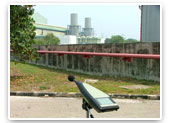
In a situation where there can be leaks around a door, through which sound can pass, there will be reduced sound attenuation. Therefore, not only does the fabrication period of FREETECH Acoustic Door is carried out in great care..
Freedom Technology Sdn. Bhd.
No. 7, Lot 15832, 1st Floor, Setia Commercial Centre,
Jalan Setia Raja
93350 Kuching,
Sarawak, Malaysia.
Tel: +6082 362626 / 362941
Fax: +6082 361331
Our Services
NOISE MONITORING MEASUREMENT: NOISE MAPPING
The Factory & Machinery (Noise Exposure) Regulation 1989 requires factories to conduct initial exposure monitoring. The purpose is to determine whether any of employee/s is exposed to noise greater than the action level of 85 dB (A).
 The said Regulations also clearly stated that all employers are to reduce and control the workers exposure to a noise level below the permissible exposure limit of 90 dB (A) for 8 working hours. The higher the sound level, the shorter the duration of exposure is permitted.
The said Regulations also clearly stated that all employers are to reduce and control the workers exposure to a noise level below the permissible exposure limit of 90 dB (A) for 8 working hours. The higher the sound level, the shorter the duration of exposure is permitted.
This noise exposure monitoring report was based on the data compiled and information given by the area occupier or his representatives on the monitoring day/days. As the results withdrawn were much depends on the working conditions during the day/days mentioned below, I reasonably believe that samples taken represent the greatest daily noise exposure in the workplace. Therefore it can be used as reference for worker’s daily exposure and if there are any changes in the process or machinery, then this report is considered null and void.
AREA MONITORING
Area Monitoring is a procedure of identifying the noise created by the machineries within the said area which may exceed the Permissible Exposure Limit of 90 dB (A).
Our first survey was conducted by “a walk-through assessment” in order to help us to define the noise problem and provide the basis for a noise measurement and control plan. It was also a familiarization for us on the location and the names of the equipments given here. By having this assessment, it was actually an informal audit of noise source, possible noise controls and management measures to reduce noise exposure.
Subsequently, zoning will be done to identify the specific noise sources within the area. The layout of the area with machinery location is drawn. Then, the noise contours of below 85 dB (A), 85 to 90 dB (A) and above 90dB (A) are sketched on the plan and are colored for easy identifications. This is conducted by walking with the meter to the mark the distance from the noise sources for each noise contour being measured. All the points for each contour are jointed to complete the zone.
Types of noise are also recorded during this procedure.
PERSONAL EXPOSURE MONITORING
Personal noise exposure monitoring is carried out to indicate the extent of the severity of an employee’s noise exposure. Method of this monitoring are as described below.
- Since this is an initial monitoring, only one worker from each noisy area is selected to undergo personal exposure monitoring to represent his group. The selection was based on the fact that he was exposed to the highest exposure to noise. The purpose and usage of the dosimeter is explained to the worker and his personal data (Name, IC and Employees No.) were recorded.
- The instrument then was turned on into dosimeter mode. All previous data are cleared by pressing and holding the reset button.
- The microphone of the dosimeter is clipped to the shirt’s collar of the worker (near to his ear). The RUN key was pressed and the security cover was installed. The dosimeter then was placed and fixed in the workers shirts pocket.
- The worker was instructed not to remove or interfere with both the dosimeter and microphone. It was explained that the dosimeter will not interfere with his normal duties and will be removed after his has completed his job for the day. In order to ensure that the monitoring was running smoothly, the worker were visited and supervised during the course of the monitoring.
- At the end of the monitoring period, the dosimeter and the security cover were removed and the pause key is pressed to stop recording. The calibration level was rechecked once it was removed to ensure that it is the same as prior to the monitoring.
- The results were printed out by connecting the cable to the laptop.
- Work sections were done based on the information from the factory management and through observation.
